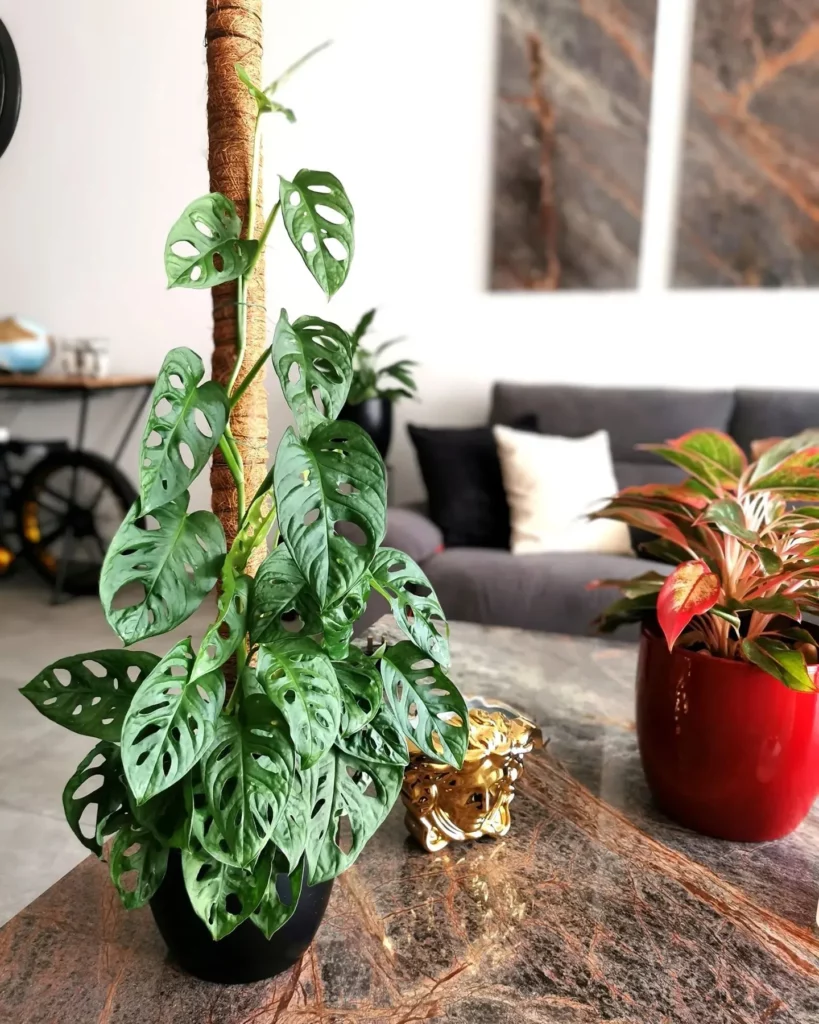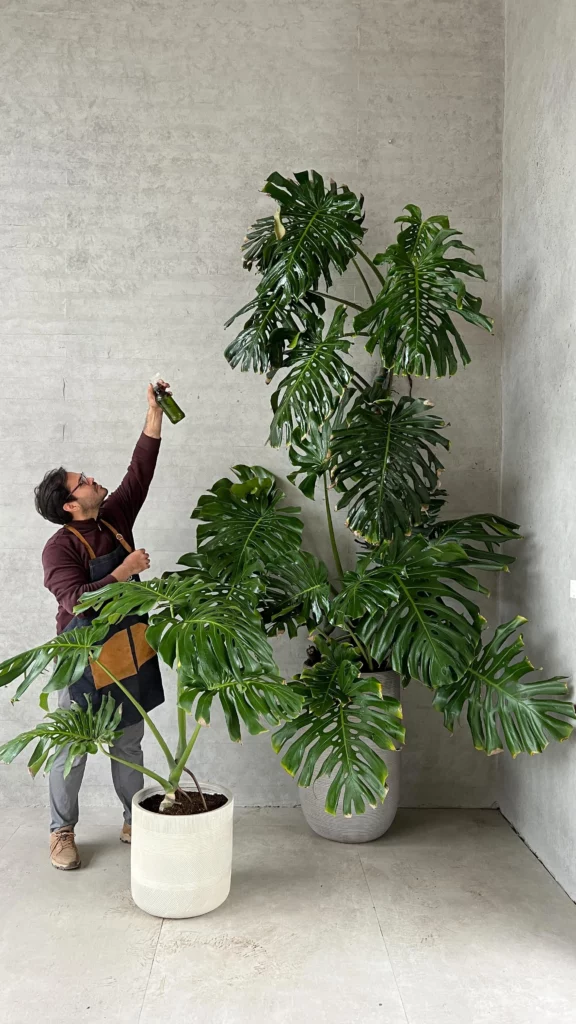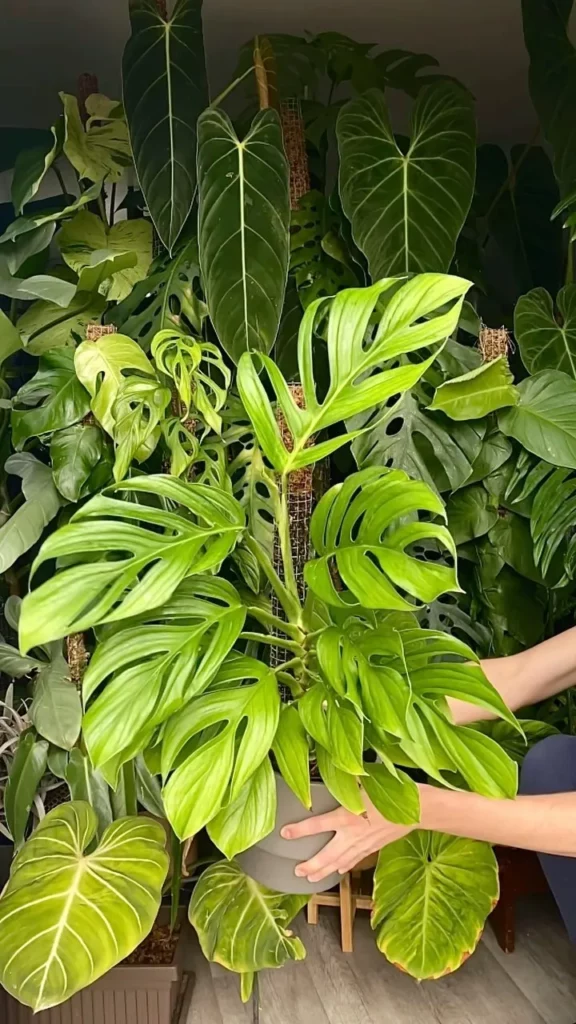Welcome to my guide on Monstera propagation! If you’re a plant lover like me, you’ll be thrilled to learn how to grow new Monstera plants from cuttings. There are two popular methods for propagating Monstera cuttings: water propagation and soil propagation. Each method has its own unique benefits and considerations.
Key Takeaways:
- Monstera propagation involves growing new plants from cuttings of a mother plant.
- The two most common methods of propagation for Monstera plants are water propagation and soil propagation.
- Water propagation involves placing stem cuttings in water until they develop roots.
- Soil propagation involves planting the cuttings directly into potting soil.
- Understanding the differences between these methods is crucial for successful Monstera propagation.
Benefits of Houseplant Propagation



There are several benefits to propagating houseplants – it’s an environmentally friendly practice as it allows you to save clippings from the compost bin and create new plants. By reusing plant material, you reduce waste and contribute to a more sustainable lifestyle.
Propagation can also be a lifesaver for struggling plants, giving them a chance to thrive again. Instead of giving up on a wilted or dying plant, you can propagate it and nurture it back to health.
One of the joys of houseplant propagation is the opportunity to share the love with others. When you successfully propagate a plant, you can gift cuttings to friends and family, spreading the beauty and benefits of houseplants. It’s a personalized and thoughtful gift that keeps on giving as the recipient watches the cutting grow into a full-fledged plant.
Propagation also promotes full growth patterns in mature plants. By trimming back the foliage and encouraging new growth, you can help your plants stay vibrant and lush.
Advantages of Propagating Houseplants:
- Environmentally friendly practice, reducing waste
- Revival of struggling plants
- The joy of sharing love and beauty with others
- Promotes full growth patterns in mature plants
No products found.
Tools and Materials for Plant Propagation



When it comes to propagating plants, having the right tools and materials is essential for success. Here are the key items you’ll need to ensure a smooth and efficient propagation process:
1. Sharp Shears or Scissors
A quality pair of sharp shears or scissors is crucial for taking clean and precise cuttings. This helps prevent any damage or trauma to the mother plant and ensures the best chances of successful propagation.
2. Rooting Media
Depending on the method you choose, you’ll need different types of rooting media. For water propagation, you’ll need clean, filtered water. If you opt for soil propagation, have potting soil ready. Other alternatives include peat moss, perlite, or a mixture of these materials.
3. Vessel for Rooting
You’ll need a suitable vessel to hold the rooting media and the plant cuttings. Glass jars or bottles are commonly used for water propagation, while pots or containers work well for soil propagation. Ensure that the vessel provides enough space for the roots to grow.
4. Rooting Hormone (Optional)
Rooting hormone can help stimulate root growth in some plant species, increasing the success rate of propagation. While optional, using rooting hormone can significantly improve the chances of successful root development in certain plants.
5. Humidity Container or Dome
Creating a humid environment is crucial for successful propagation. A humidity container or dome can help maintain the ideal moisture levels around the cuttings, promoting root development. This can be as simple as using a clear plastic bag or investing in a specialized humidity dome.
6. Watering Can
Keeping the rooting media consistently moist is essential for proper propagation. A watering can with a fine nozzle or a spray bottle can help you control the amount of water you provide, preventing over or under-watering.
Water Propagation



Water propagation is a popular and effective method for propagating Monstera and other houseplants. This method involves placing stem cuttings in water until they develop roots, which then allows them to be transplanted into potting soil. To propagate a Monstera cutting in water, start by cutting a 3- to 4-inch piece of stem just below a leaf node. Remove the lower leaves to prevent rotting, and then place the stem cutting in a glass vessel filled with filtered water. It’s important to change the water every few days to prevent any stagnant conditions that could hinder root development.
Over the course of the next 2 to 4 weeks, you’ll start to see roots develop and grow 1 to 2 inches long. This is a sign that the cutting is successfully propagating. Once the roots are established, it’s time to transplant the cutting into a pot with potting soil. Gently remove the cutting from the water, being careful not to damage the delicate roots, and plant it into the soil. Make sure to keep the soil lightly moist as the cutting continues to establish itself in its new environment.
Advantages of Water Propagation
- Water propagation allows you to easily observe root development, as the roots are visible in the water.
- This method provides a controlled environment for the cutting, ensuring proper moisture levels to support root growth.
- It’s a simple and cost-effective method, as it requires minimal tools and materials.
- Water propagation can be a great option for beginners, as it doesn’t require as much expertise or experience as other methods.
Soil Propagation



Soil propagation is an effective and straightforward method for propagating plants, including Monstera. To successfully propagate a Monstera cutting in soil, start by selecting a stem with at least one node. Carefully remove any lower leaves to prevent rotting and dip the bottom of the cutting in rooting hormone for faster root development, if desired. Next, plant the cutting in a pot filled with moist potting soil, making sure to bury the node and leave the upper leaves exposed.
Once planted, you’ll want to keep the soil lightly moist by watering as needed. To help create a humid environment, consider covering the pot with a plastic bag or using a humidifier. Place the pot in a location with bright, indirect light and avoid direct sunlight, as it can scorch the cutting. With proper care and time, you’ll start seeing new plantlets forming around the base of the cutting, indicating successful propagation.
Key Steps for Soil Propagation:
- Select a stem with at least one node.
- Remove any lower leaves and dip the bottom of the cutting in rooting hormone (optional).
- Plant the cutting in a pot filled with moist potting soil, burying the node and leaving the upper leaves exposed.
- Keep the soil lightly moist and provide humidity by covering the pot with a plastic bag or using a humidifier.
- Place the pot in a bright, indirect light location and avoid direct sunlight.
- Monitor the cutting for new plantlets forming around the base, indicating successful propagation.
Division Propagation



Another effective method for propagating plants, including Monstera, is division propagation. This method is particularly suitable for plants that produce stems at their base. To divide a Monstera plant, I carefully remove it from its pot and separate it into smaller sections, ensuring that each section has some roots.
Once I have divided the plant, I plant each new section in its own pot filled with potting soil and water them thoroughly. Providing these new sections with adequate light and caring for them as I did the mother plant ensures their successful growth. Division propagation not only allows me to create new plants, but it also helps maintain the health of the original plant.
Dividing plant roots is a great way to expand your plant collection or share your plants with others. If you have a Monstera or similar plant that produces stems at its base, division propagation is definitely a method worth trying.
Tips for Successful Propagation



Propagating plants can be a rewarding and exciting process, but it does require some knowledge and care. Here are some tips to help you achieve successful propagation:
- Choose the right time: Propagate your plants during the spring or summer when they are in their active growing phase. This will give the cuttings the best chance of rooting and establishing themselves.
- Use sharp and clean tools: When taking cuttings, make sure to use sharp and clean shears or scissors. This will help prevent any infections or diseases from spreading to the cuttings.
- Create the ideal environment: Different plants have different needs, so it’s important to provide the right conditions for your cuttings. This includes providing adequate light, humidity, and moisture for the cuttings to thrive.
- Be patient: Propagation takes time, so it’s important to be patient and give the cuttings time to develop roots and new growth. Avoid disturbing or moving the cuttings too much, as this can disrupt their progress.
- Experiment and learn: Don’t be afraid to try different methods and techniques to see what works best for you and your plants. Each plant is unique, and what works for one may not work for another. Enjoy the process of learning and experimenting!
Maintaining Newly Propagated Plants



Once you have successfully propagated your plants, it’s important to provide them with proper care to ensure their continued growth and health. Here are some tips to help you maintain your newly propagated plant cuttings:
- Monitor for transplant shock: After transplantation, keep an eye on the plants for any signs of stress, such as yellowing or wilting leaves. If you notice any such signs, keep the soil moist and consider trimming back some foliage to redirect energy towards root growth.
- Watering: It’s crucial to water the newly propagated plants appropriately. Maintain the right moisture levels by checking the soil regularly. Ensure the soil is moist but not soggy, as overwatering can lead to root rot.
- Light exposure: Provide the newly propagated plants with the appropriate amount of light. Most houseplants prefer bright, indirect light, so place them near a window where they can receive filtered sunlight. Avoid exposing them to direct sunlight, as it can scorch their delicate leaves.
- Occasional pruning: As your propagated plants grow, occasional pruning may be necessary to maintain their shape and encourage healthy growth. Remove any dead or yellowing leaves to prevent the spread of disease and pests.
Sharing the Joy of Propagation



Once you have successfully propagated your plants, it’s time to share the joy with others. There are various ways you can spread the love of plant propagation and connect with fellow plant enthusiasts.
1. Gifting Plant Cuttings
Instead of traditional gifts, consider gifting plant cuttings to your friends and family. It’s a unique and meaningful present that allows them to grow their own plants and experience the joy of propagation.
2. Participating in Plant Exchanges
Joining plant exchanges is a fantastic way to expand your collection and meet other plant lovers. These events or online communities provide opportunities to swap cuttings and learn from others who share a passion for propagation.
3. Joining a Plant Propagation Community
Being part of a plant propagation community can be incredibly rewarding. You can connect with like-minded individuals, share your experiences, learn new techniques, and even organize plant propagation workshops or meetups.
Conclusion: Mastering the Art of Propagation
After diving into the world of plant propagation, I have discovered the joys and rewards that come with it. By understanding the different methods such as water propagation, soil propagation, and division propagation, I have unlocked the secret to multiplying my plant collection. Through trial and error, I have learned the importance of using the right tools and materials, from sharp shears for taking cuttings to rooting hormone for an extra boost.
But it doesn’t end there. Proper care is crucial for the success of the cuttings. I have found that providing the ideal environment with adequate light, humidity, and moisture is essential for their growth. And as I patiently watched my propagated plants develop roots and new growth, I realized that the process requires patience and a little bit of experimentation.
FAQ
What is propagation?
Propagation is the process of growing new plants from the roots, stems, or leaves of a mother plant.
What are the two most common methods of propagating Monstera plants?
The two most common methods of propagating Monstera plants are water propagation and soil propagation.
What are the benefits of propagating houseplants?
Propagating houseplants is environmentally friendly, can save a dying plant, allows you to share plants with others, and promotes full growth in mature plants.
What tools and materials do I need for plant propagation?
You will need sharp shears or scissors, different types of rooting media, a vessel, rooting hormone (optional), a humidity container or dome, and a watering can.
How do I propagate Monstera cuttings in water?
Cut a 3- to 4-inch stem below a leaf node, remove lower leaves, and place the cutting in a glass vessel filled with filtered water. Change the water every few days until roots develop.
How do I propagate Monstera cuttings in soil?
Cut a stem with at least one node, remove lower leaves, dip the bottom of the cutting in rooting hormone (optional), and plant it in a pot with moist potting soil.
How do I propagate Monstera plants by division?
Carefully remove the plant from its pot, separate it into smaller pieces with roots, and plant each new section in its own pot filled with potting soil.
What are some tips for successful plant propagation?
Propagate plants in the spring or summer, use clean tools for cuttings, provide the right environment (light, humidity, moisture), be patient, and experiment with different methods.
How do I maintain newly propagated plants?
Watch for signs of transplant shock, keep the soil moist, redirect energy towards root growth by trimming foliage, fertilize after a month, and provide regular maintenance (watering, light exposure, pruning).
How can I share the joy of plant propagation with others?
Gift plant cuttings to friends and family, participate in plant exchanges, or join a plant propagation community to share cuttings with fellow enthusiasts.
How can I become a successful propagator?
Understand different propagation methods, use the right tools and materials, provide proper care, be patient, and enjoy watching your plant babies grow and thrive.




